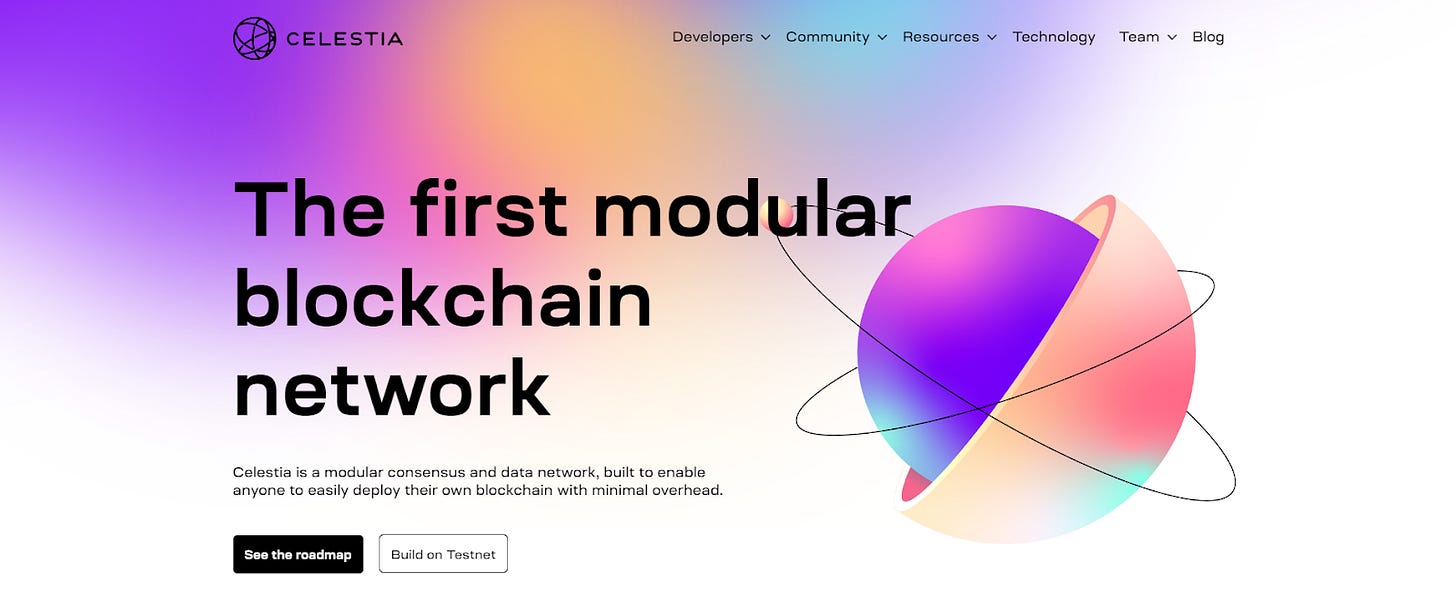Celestia — Modular Blockchains and The App-Chain Thesis.
Celestia is being hailed as one of the most critical base-layer blockchains developed recently. Celestia is a modular blockchain network that makes it simple to introduce new blockchains. It enables sovereign blockchains to escape the limitations of monolithic blockchain architectures so they can build freely and adaptable according to their own needs.
The sole purpose of Celestia, a distinct layer 1 blockchain, is to order transactions and confirm the availability of published data. This makes it possible to deploy special-purpose blockchains for hosting applications on top of it. This architecture allows Celestia to be scalable, flexible, and have excellent interoperability support. To understand why Celestia is such a big deal, it is essential to understand two key concepts:
The app chain thesis.
The difference between modular and monolithic blockchain designs
Let’s examine these key concepts:
The App-Chain Thesis: An Overview
App chains had been proposed previously by Vitalik Buterin in 2017, in the Plasma Whitepaper. App chains are viewed as the next step in the evolution of blockchains. Some commentators have dubbed Celestia the “Amazon Web Service of Web3” since it allows different decentralized applications (DApps) to be quickly launched.

The App chain thesis suggests that the future of DApps is such that these apps will run on specialized specific chains similar to how the modern web apps run on app-specific virtual machines that run on shared physical machines.
Consider the tweet below:


Blockchain Architecture: Monolithic Versus Modular Design.
In the monolithic blockchain, the base layer is responsible for handling the execution of transactions, coordinating consensus mechanisms, and ensuring data availability. However, a modular blockchain like Celestia decouples the execution layer from the consensus and data availability layer. In the case of Celestia, the sole purpose of the Celestia blockchain is to order transactions and confirm data availability.

Looking at the monolithic blockchain design, we can start to detect several problems that can arise as the blockchain grow in size and attains critical mass. Some of these problems with monolithic blockchain architecture include the following:
Reduce decentralized application (DApp) flexibility and programmability: Since monolithic blockchains have laid down rules, the applications deployed on these blockchains must follow the blockchain rules. This restricts features like the ability to fork and create a flexible codebase.
High hardware requirements: Given that a lot of transactions are happening simultaneously on the monolithic blockchain, there are increased gas costs for end users and increased hardware requirements for nodes to verify transactions on the chain.
Validator Bootstrapping: To kick off activity on a monolithic blockchain, there has to be an existing network of validators. Who will ensure consensus and maintain the state of the blockchain.
A modular blockchain architecture solves several of the above challenges and offers the following benefits:
Increased Security: On the monolithic blockchain design, whenever a new blockchain is launched, there is an immediate need to attract enough validators to maintain the network's security. On a modular blockchain infrastructure like Celestia, new apps can quickly be launched while tapping into the security of the base layer.

Source: Celestial Blog Scalability: The Celestia blockchain is more scalable since, as the DApp ecosystem continues to increase, there is no tussle between apps for block space on the blockchain. On a monolithic blockchain infrastructure, there is a tussle between DApps on the blockchain, often making the network slow and, at times, unusable.
Programmability and Sovereignty: Each modular chain on the Celestia blockchain can create a set of rules for themselves, unique to their needs, unlike DApps launched on monolithic blockchains that have to abide by the rules of the base layer.
Final Words
At Fifty Finney Research, we are excited about the prospects of Celestia. The development of Celestia is still in its infancy. The project opened the Mamaki testnet for development teams to publicly test the network's features and functions in May 2022. The testnet will be upgraded in 2022, and a mainnet launch is scheduled for 2023.
We are excited to see how the app-chain wars shape up and thought to shine a light on the value proposition of Celestia. Other protocols implementing using the app-chain thesis include Avalanche with the subnet model, Cosmos with Cosmos Zones, and Polkadot with Parachains.
We encourage you to examine all the innovations going on in the space.
If you enjoyed this post do well to follow Fifty Finney Research on Twitter, you can also join our telegram community.
Further Reading
Modular vs. monolithic: a beginner's guide - https://blog.celestia.org/modular-vs-monolithic-a-beginners-guide/
What Is Data Availability? - https://coinmarketcap.com/alexandria/article/what-is-data-availability
Plasma Whitepaper - https://www.plasma.io/plasma.pdf.


